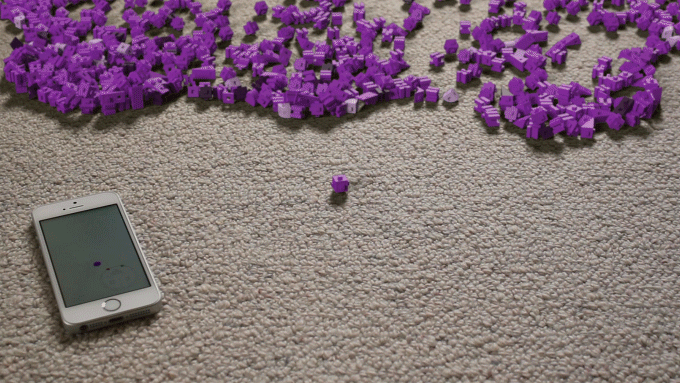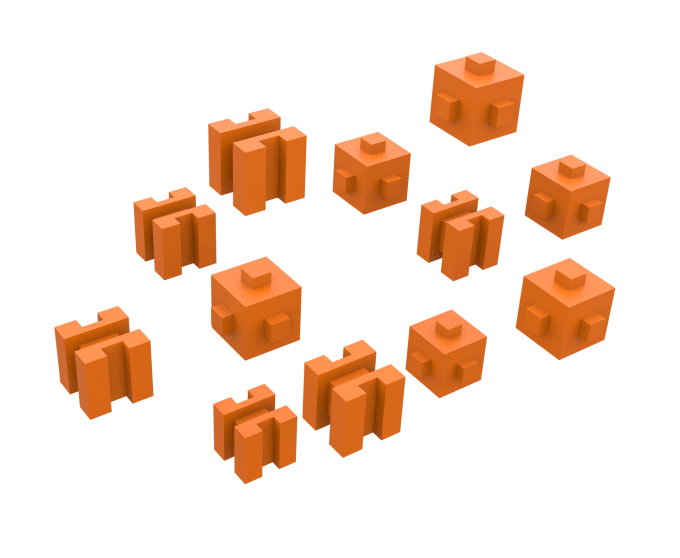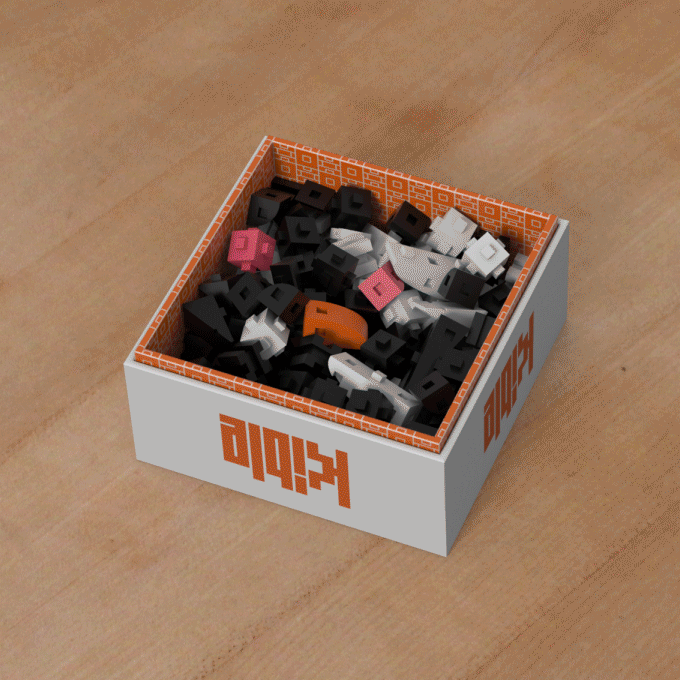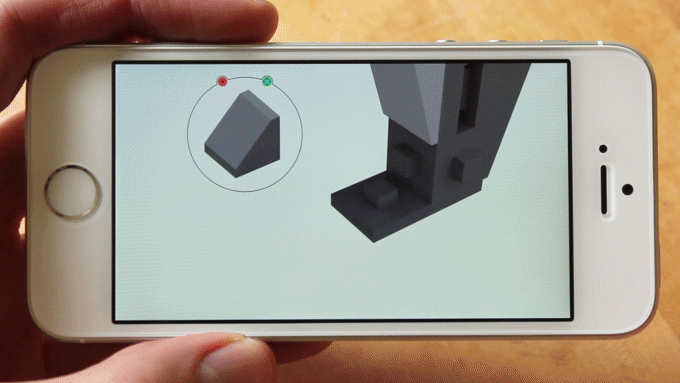Featured Maker: Jason Brain of Kible
When you ask architects which toys they played with as a child, many will list toys like Lincoln Logs, K’Nex, and the infamous Lego. With each toy system’s ability to break a larger object down into pieces helps the child (of any age) build a spatial awareness and develop a basic understanding of building tectonics, which makes sense why it would help inform a path towards architecture. Jason Brain, an alumnus of Harvard’s Graduate School of Design (a.k.a. “The GSD”) shares with us how he reimagined the snapping block system entirely taking it from App to Model to make the system better and more flexible with Kible.
Can you share the origin story of Kible?
I remember (architect/artist) Maya Lin referring to her studio process as “laying an egg.:” That really resonated with me. The idea for Kible came to me in a weekend but took a year and a half of care and nurturing to fully design and develop.
I started designing Kible in the winter of 2015, although much of my life has led up to this project. As a child, I won the LEGO Master Builder Award and pursued my interest in design at college and then Harvard’s Graduate School of Design.
—Jason Brain, from the Kible Kickstarter page
Why did you name the project, “Kible”?
There are a few reasons. For one, I don’t think of Kible as having bricks like Lego, but it goes without saying that Kible involves lots of little pieces, so one could say it’s like an inedible kibble of sorts. And my Portuguese studio critic once said about a pile of unassembled laser-cut chipboard model: “This looks like food-dog!” I guess it stuck.
What is the goal of this project?
In short: to create a snapping block system that responds to the aesthetic and experiential expectations of the 21st century. I wanted to make a simple, elegant, omnidirectional block system that was easy to use for adults and children. I also wanted to create a digital modeling app as a component of the building system that was fun to for girls and boys. It was important to me that it be a social, collaborative experience giving users purchase options. Users know what they want to build and shouldn’t have to wait for the top-down retail process.

Kible in Action! Video courtesy of Kible.
I’m sure you’ve been asked about the difference between Kible and Lego. How is Kible different?
Kible is unique for its omnidirectional snapping system. Unlike the vertical snapping system of Lego, Kible allows you to build in all directions, making the creative experience more open-ended. With its expanse of color options and our strategy to make it more accessible to all genders, Kible allows for flexibility in all aspects.

Kible’s Omnisnap System. Video courtesy of Kible.
How does Kible work?
- Download the app.
- Design your model on the modeling app with over 25 unique shapes including cubes, wedges, slopes, ramps, and slabs.
- Purchase the Kible components.
- Build your model in real life! (see video below)


Building a Bronto. Video courtesy of Kible.
CHALLENGE: Design a building or an object of choice with the Kible system. Show it off by using #imadethat for a chance to be posted on our Instagram with over 28,000 followers!
Tell us about how you got here.
I’m from the Seattle area, grew up tromping through the woods after school, making tons of forts. I grew up sailing around the Salish Sea from Bainbridge Island, to the San Juan Islands, and up into British Columbia. I feel very lucky to have grown up in those environments, I believe that they fueled my imagination for use later in in life. And, like a lot of architects, I have always loved music, and play the mandolin and mandocello.
Additionally, as an unabashed product of the liberal arts, I try to maintain my literacy in various mediums, whether that be literature proper, expository and creative writing, coding, cooking, various art tools and computer programs, so on and so forth.
Why did you choose to study Landscape Urbanism and Experience Design?
So back in 18th century England, there was this guy you might have heard of called Humphry Repton. I went to the Harvard Graduate School of Design, in essence, hoping to become a sort of neo-Repton with the goal of taking those skills into cinematic production design. I knew that architects were getting into film and animation, and I thought that entering this competitive industry might be best achieved from an oblique angle (i.e. “left field”), such as landscape architecture. Kind of funny, right?
Toward the end of my undergraduate studies, I started to focus on traditional animation and painting techniques, with the overall intention of entering production design. Perhaps naively, I thought that because landscape architecture has its roots in painting and in a sense set design or “scene geography”, that enrolling in the GSD’s MLA1 program would make me a killer design-illustrator, well suited for any art department in any film studio. I was fortunate to be surrounded by a cadre of fellow alt-architects, many of whom were also interested in various contiguous disciplines, including production design, product design, video game production, narrative design, and entrepreneurship.
How did your undergraduate in Multimedia Design and Philosophy shape your design education?
I knew that I wanted to get into the animation industry, but decided to opt for a “well-rounded” liberal arts career instead. I wanted to keep any and all career options open. Apropos my first remark about the Maya Lin studio process of laying an egg by way of writing out ideas, I still feel that the most valuable design education I received derived from my philosophy and literature coursework. I found a lot of freedom in the humanities departments to explore my design projects.
What was your time at the GSD like? Did you have a favorite course? Favorite professor?
From the very beginning, I was labeled as somewhat of an insubordinate student, along with a few others, who coincidentally also came from the liberal arts. I couldn’t help questioning the syllabi, curricula, and pedagogy of the studio in general. However, almost all of my professors wholeheartedly supported my pursuits and critical inquiries. Anita, Brad, JDH, PDT, Rosetta, Silvia, Pierre; all good people.
If I had to choose, I’d say my favorite professors were Chad Oppenheim of Oppenoffice (Miami), and Eric de Broche des Combes of Luxigon (Paris/LA) and their class titled: Immersive Landscapes. Chad’s and Eric’s class was a sort of catch-all production design, video game design, interactive and experience design course that introduced me to Unity and C# coding. Thanks to Chad’s and Eric’s extensive professional network, we always had amazing guest speakers, many of whom I had the honor of meeting up with after class for a drink or dinner along with a few other students. When the Oscar-winning Pixar production designer Ralph Eggleston gave a talk and then invited me to sushi, I thought: The stars have aligned, here’s my entry to animation production design! Well, almost, but that’s another story. I’ll say this much: Chad, Eric, and Ralph are all generous and talented mentors, and the sushi was great.
How does your design background shape this project, Kible?
In terms of contemporary vocational categories, I would probably be labeled as a “Play Designer” (I saw it on the IDEO website, so it’s real.) I think “play design” best describes the various projects and pursuits I’ve endeavored throughout my life, including Kible.
What’s interesting about play design is that it often involves the development of products and systems that integrate both the digital with the tactile, a technological mixture that will surely constitute many things to come. From a personal standpoint, in terms of enjoying one’s day to day grind, I get a kick out of working on such projects that require a multidisciplinary array of tools and activities.
How do you use your skills attained in graduate school in your current position at Kible?
I learned a lot of technologies while at the GSD. In the first two weeks, we were all introduced to Rhino, AutoCAD, GIS, and 3ds Max, but only superficially and then the rest was up to us. That said, designing Kible as a physical and digital product employed the following proficiencies: Rhino, Python, Unity, C#, prototyping, industrial materials, injection molding, and a lot of endurance tempered by patience.
One of the most valuable things I learned at Harvard was how to focus intensely on a project, at my computer, usually alone, and then flip the mental switch to present my idea to an audience. As a startup venture, Kible has required me to do this at a whole new magnitude, flying down to Silicon Valley and presenting to wizbang investors, or pitching to industry experts over the phone after a week straight of solitary computer work. Either way, the GSD absolutely introduced me to this. Honestly, keeping one’s cool throughout this studio-to-presentation schtick is a lifelong practice, at least for me.

How Kible works. GIF courtesy of Kible.
Can you share a word of advice to students seeking to study architecture and design?
- Get some professional experience. Discover your strengths and interests before enrolling in a professional architecture program.
- Sleep. Sleep is productive. Sleeping and perambulating are when some of my best insights arrive. Don’t be a worker bee, unless you want to be. As my aforementioned Professor Eric once told me,”Be careful about becoming very good at one thing, as that is what will be expected of you in the office.” This isn’t to suggest mediocrity as a strategic goal, rather maintain professional buoyancy by staying excited and imaginative about your work and growing your skill set.
- Take creative risks. Despite all the wrist slapping, school is not a job and no one is going to fire you. Be your own boss while you have a chance to at school, and don’t be afraid to appropriate aspects of the profession toward something that calls you elsewhere, where that be fashion, film, DJing, humanitarianism, gardening, toys, games, writing, what have you!
Fun fact: Etymologically architects are the “chief buildings” likewise, pedagogically, architecture is the chief discipline: it encompasses and presides over so many more opportunities than many will openly admit. Don’t limit yourself—be an architect in the fullest sense of the word!
To learn more about Kible, check out their kickstarter campaign.
For information on Harvard GSD, check out their profile page.
